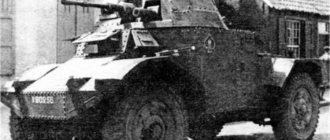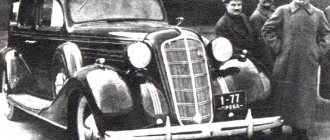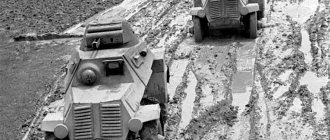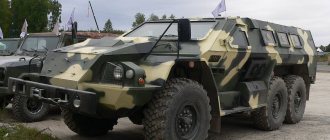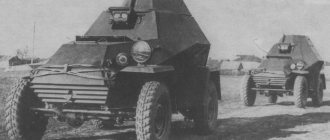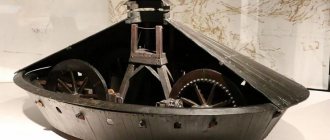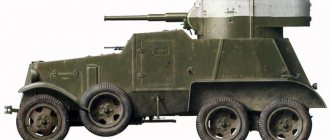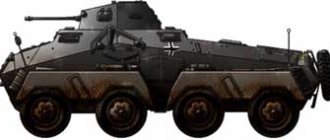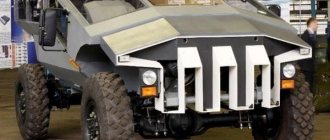Armored car BA-20 TTX, Photo, Speed, Armor
BA-20 is a Soviet light armored vehicle from the 1930s. Developed on the chassis of the GAZ-M1 passenger car as a light armored vehicle for reconnaissance, communications and security of the Red Army, it was mass-produced from 1936 to 1942 in several versions.
The armored car was produced from 1938 to 1941 inclusive (a small number of BA-20 vehicles were still produced at the beginning of 1942 from the remaining stock of parts). It was created on the chassis of the GAZ-M1 passenger car, which was mass-produced since 1936. The body is welded from rolled armor plates. The fighting compartment was located in the rear of the armored car. A 7.62 mm machine gun was installed in the turret mounted here in a ball joint. The permissible elevation angle of the machine gun in the ball joint was 23 degrees, and the angle of descent was 13 degrees.
The armored car was equipped with bullet-resistant tires filled with spongy GC rubber. The 71-TK-1 radio station with a handrail antenna was used as a means of communication, which was replaced with a whip antenna during the modernization carried out in 1938. The vehicle was widely used in the Red Army as a means of commander reconnaissance, communications and combat security. An option was also developed for rail travel at a speed of 80 km/h.
In 1936, on the basis of the two-axle GAZ-M1 passenger car, produced at the Gorky Automobile Plant in the same year, the Vyksa plant began mass production of the BA-20 armored vehicle, which continued until the very beginning of the Great Patriotic War. This light armored vehicle, like its modernized version BA-20M, became the most popular wheeled combat vehicle of the Red Army. The BA-20 armored car was built according to a layout with a front engine and a rear fighting compartment, the front wheels were steering, the rear wheels were driving.
The completely enclosed all-welded body of the BA-20 armored car was made of sheets of rolled steel with a thickness of 4 mm to 6 mm, which were installed on the sides with small angles of inclination. For the front and rear sheets, this angle was much greater, which increased their bullet resistance. This armor provided protection for the two-person crew from ordinary bullets fired from a distance of 80-100 m. For the crew to enter and exit the vehicle, there were rectangular doors with external hinges on the sides. At the bottom of the stern sheet there was a bracket on which spare wheels were mounted.
The armored car was produced from 1938 to 1941 inclusive (a small number of BA-20 vehicles were still produced at the beginning of 1942 from the remaining stock of parts). It was created on the chassis of the GAZ-M1 passenger car, which was mass-produced since 1936. The body is welded from rolled armor plates. The fighting compartment was located in the rear of the armored car. A 7.62 mm machine gun was installed in the turret mounted here in a ball joint. The permissible elevation angle of the machine gun in the ball joint was 23 degrees, and the angle of descent was 13 degrees.
The armored car was equipped with bullet-resistant tires filled with spongy GC rubber. The 71-TK-1 radio station with a handrail antenna was used as a means of communication, which was replaced with a whip antenna during the modernization carried out in 1938. The vehicle was widely used in the Red Army as a means of commander reconnaissance, communications and combat security. An option was also developed for rail travel at a speed of 80 km/h.
In 1936, on the basis of the two-axle GAZ-M1 passenger car, produced at the Gorky Automobile Plant in the same year, the Vyksa plant began mass production of the BA-20 armored vehicle, which continued until the very beginning of the Great Patriotic War. This light armored vehicle, like its modernized version BA-20M, became the most popular wheeled combat vehicle of the Red Army. The BA-20 armored car was built according to a layout with a front engine and a rear fighting compartment, the front wheels were steering, the rear wheels were driving.
The completely enclosed all-welded body of the BA-20 armored car was made of sheets of rolled steel with a thickness of 4 mm to 6 mm, which were installed on the sides with small angles of inclination. For the front and rear sheets, this angle was much greater, which increased their bullet resistance. This armor provided protection for the two-person crew from ordinary bullets fired from a distance of 80-100 m. For the crew to enter and exit the vehicle, there were rectangular doors with external hinges on the sides. At the bottom of the stern sheet there was a bracket on which spare wheels were mounted.
BA-20 with troops on board
In the control compartment of the armored car, located behind the engine compartment, there was a driver's seat on the left, and a vehicle commander's seat on the right. Visibility was provided by two front windows equipped with armored covers with viewing slots, and two viewing slots in the side doors. On the roof of the rear part of the hull there was a conical turret of circular rotation with a small armored dome, which was the cover of the turret hatch and folded back when opened. A 7.62-mm DT machine gun was mounted in the front plate of the turret in a ball mount, aiming at the target in a vertical plane in the sector from -13° to +23°. The ammunition it carried consisted of 1,386 rounds of ammunition. The rotation of the tower was carried out manually using a mechanical drive.
A four-cylinder in-line carburetor liquid-cooled GAZ-M1 engine was installed in the front part of the hull in the engine compartment, which developed a power of 36.7 kW (50 hp), which allowed the armored vehicle to move on roads with a hard surface at a maximum speed of 90 km/h. When fully refueled, the BA-20 armored car could travel from 270 to 350 km, depending on the road.
Light armored vehicles BA-20 before being sent to the front. The first row consists of vehicles equipped with 71-TK-1 radio stations with a handrail antenna.
Access to the engine and its components for the purpose of repair and routine maintenance was provided by a hinged cover of the upper part of the armored hood and service hatches in the sides of the engine compartment that folded upward. The front armor plate of the latter, stamped in the shape of a wide V, had two movable flaps on hinges, which regulated the flow of cooling air to the radiator and engine. In a combat situation, the armored doors were closed to prevent damage to the radiator from bullets and fragments of shells and mines. Air circulation in the engine compartment was ensured by a narrow movable panel, which was located behind the hinged cover of the armored hood. The rear-wheel drive (4x2) chassis with reinforced suspension on semi-elliptical leaf springs used wheels with bullet-resistant GK tires filled with sponge rubber. The front and rear wheels were covered by streamlined fenders, which at the bottom connected with the footboard, forming a single whole with it. Boxes with spare parts and tools were mounted on the running boards in front of the rear fenders.
Due to the incomplete drive, the BA-20 armored car had limited maneuverability when driving over rough terrain. Its traction properties also left much to be desired - the car could overcome an incline of no more than 15°. For driving in the dark, the armored vehicle was equipped with headlights mounted on the front wings on both sides of the frontal sheet of the engine compartment.
Shot down BA-20
The standard equipment of the BA-20 reconnaissance armored vehicle included a 71-TK-1 radio station and a handrail antenna mounted on brackets around the body at roof level. In 1936, a version of the armored vehicle for rail travel was built. This modification, designated BA-20zhd, with a combat weight of 2.78 tons, developed a speed of 80 km/h on rails and had a cruising range of 430-540 km. The crew of the BA-20zhd consisted of three people.
The modernized version of the BA-20M appeared in 1938 and differed from the base vehicle in a new conical turret, the presence of an additional fuel tank and a new radio station 71-TK-3. Accordingly, instead of a handrail antenna, a whip antenna was installed. With a crew of three people, the combat weight of the BA-20M increased to 2.52 tons, which did not have the best effect on the suspension and maneuverability of the armored vehicle. The maximum speed of the car dropped sharply and was only 50 km/h.
The BA-20 and BA-20M armored vehicles were in service with the Red Army and took part in combat operations on the Khalkhin Gol River, on the Chinese Eastern Railway, and then on the fronts of the Great Patriotic War.
In the summer of 1941, German troops captured about a hundred BA-20 and BA-20M armored vehicles. Captured vehicles ended up in police units and SS troops under the designation VA 20(r) and VA 202(r), respectively. The BA 202(r) armored vehicles were in service with various units, including the 741st SS Volunteer Mountain Division "Prinz Eugen". The BA-20zhd armored cars, adapted for movement on railway tracks, were used by the Germans as reconnaissance vehicles as part of some armored trains operating on the Eastern Front.
Options and modifications
— BA-20 — basic model with a power reserve of 350 km, produced from 1936 to 1938. in two versions: standard and radio-equipped (in the latter case, the vehicle was equipped with a 71-TK-1 transceiver radio station with a handrail antenna placed on brackets around the turret, and the crew was increased to three people at the expense of the radio operator). The body, welded from rolled steel sheets, was developed on the basis of the layout diagram of the FAI armored car, the first armored cars had a turret from the FAI armored car, the next ones had a conical turret of a new type. A total of 749 pieces were produced.
— BA-20zhd — a railway version of the BA-20 with the possibility of conversion into a light armored tire. Equipped with a set of four removable steel railway wheels with flanges for movement on rails and a jack for replacing wheels in the field by the crew. The weight of the armored vehicle increased to 2780 kg, the maximum speed decreased to 50 km/h. In total in 1938 - 1939. 61 pieces produced.
- BA-20M - a modified version, the first prototype was built in 1938, serial production began in January 1939 and continued until June 1942. The armored vehicle was built on a special GAZ-MS chassis, which had a reinforced front axle beam, reinforced springs and an additional 30-liter fuel tank. The combat weight of the BA-20M increased to 2.62 tons - the armor was strengthened, a new bullet-resistant conical turret was installed, and the radio station received a whip antenna. Since 1940, instead of the 71-TK-1 radio station, the BA-20M began to be equipped with an improved 71-TK-3 duplex radio. The range has been increased to 450 km on the highway. A total of 1230 pieces were produced.
— a railway version of the BA-20M with the possibility of conversion by the crew into a light armored tire. The speed by rail was 80 km/h, and the range was 430-540 km. In 1939 - 1941 74 were built
Armored vehicles on GAZ M-1 chassis
The only serious military purpose of the Emoks was light armored cars of two series. The first one is FAI-M
was a modernization of the FAI model, which boiled down to the replacement of the old armored hull with a new extended GAZ M-1 chassis.
FAI-M machine-gun armored vehicle with a rear platform for a spare wheel
At the same time, a fuel tank with a protective armor plate was installed on the vacated rear overhang and a spare tire was installed. According to the decision of the military commission, the vehicle had “inadequate armor” and was used as an auxiliary combat unit.
The most common armored car in the Red Army is the BA-20, based on the GAZ M-1.
In the summer of 1936, the Vyksa DRO plant began assembling a new armored car BA-20
with a more capacious body made of inclined sheets of rolled steel from the Izhora plant. It used an old turret from the FAI model or a new conical turret with a DT machine gun, bullet-resistant tires with elastic rubber filling, and a radio station with a handrail antenna mounted on brackets around the hull.
BA-20 in protection of negotiations between representatives of the Red Army and the Wehrmacht on the transfer of the city of Brest-Litovsk to the Soviet side. September 21, 1939
The railway armored car was equipped with four removable metal wheels with flanges, for installation of which a lifting jack was used. When moving on rails, the steering mechanism was blocked in the neutral position.
Railway version of the BA-20 with metal wheels. 1938
In 1939, a modernized version of the BA-20M
on a special reinforced GAZ-MS chassis. It was distinguished by a modified hull shape, a higher conical turret that expanded towards the bottom, reinforced armor and new radio equipment. This series also included a railway version with interchangeable wheels.
A column of BA-20M armored vehicles before the parade on Red Square. 1939
Armored cars of the BA-20 series took part in Soviet-Japanese clashes, the Finnish War, and at the first stage of the Great Patriotic War, almost all of them were destroyed or captured by the enemy. They were used by German police, mountain rifle and SS units. In Finland, captured vehicles were modernized and remained in military service until the early 1950s.
Repainted captured BA-20 in the Finnish village of Värtsilä (from the Esa Muikku archive)
In the field of militarized passenger cars, the Moscow Automobile Plant named after I.V. Stalin also made its contribution by creating little-known special versions of its representative model ZIS-101, which served as personal cars for the leadership of the USSR and the command of the Red Army.
Performance characteristics of the BA-20
Crew, people: 2-3 Years of production: 1936—1942 Years of operation: 1936—1957 Number of production, pcs.: 2108
Weight BA-20
— 2.52 tons
Dimensions BA-20
— Body length, mm: 4310 — Body width, mm: 1750 — Height, mm: 2130 — Base, mm: 2845 — Track, mm: 1440 — Ground clearance, mm: 240
Armor BA-20
— Armor type: rolled steel — Hull front, mm/deg.: 9 — Hull side, mm/deg.: 6 — Hull rear, mm/deg.: 6 — Bottom, mm: 4 — Hull roof, mm: 4 — Tower front, mm/deg.: 9 — Tower side, mm/deg.: 9 — Tower rear, mm/deg.: 9 — Tower roof, mm: 4
Armament BA-20
— Machine guns: 1 × 7.62 mm DT — Other weapons: radio station 71-TK-1
Engine BA-20
— Engine type: GAZ-M
Speed BA-20
— Speed on the highway, km/h: 90 — Speed on rough terrain, km/h: 36 — Cruising range on the highway, km: 350 (BA-20); 450 (BA-20M) — Cruising range over rough terrain, km: 270; 335 (BA-20M) - Specific power, l. s./t: 19.8
— Wheel formula: 4 × 2 — Suspension type: on leaf springs — Climbability, degrees: up to 15 — Climbable wall, m: 0.24 — Crossable ditch, m: 0.35 — Crossable ford, m: 0.5
Notes
- ↑ engineer E. Prochko. Staff, liaison, intelligence // magazine “Technology of Youth”, No. 5, 1983. pp. 24-25
- ↑ M. V. Kolomiets. Armor on wheels. History of the Soviet armored car 1925–1945. M.: “Yauza”, LLC “Strategy KM”, “Eksmo”, 2007. p.377
- ↑ E. D. Kochnev. Cars of the Great Patriotic War. M., EKSMO, 2010. pp.102-105
- ↑ BA-20 // L. D. Gogolev. Armored vehicles. Essays on the history of development and combat use. M., DOSAAF, 1986. pp.24-26
- ↑ M. V. Kolomiets. Armor on wheels. History of the Soviet armored car 1925-1945. M.: “Yauza”, LLC “Strategy KM”, “Eksmo”, 2007. pp. 191-204, 377-378
- L. D. Gogolev. Armored vehicles. Essays on the history of development and combat use. M., DOSAAF, 1986. p.60
- M. V. Kolomiets. Armor on wheels. History of the Soviet armored car 1925-1945. M.: “Yauza”, LLC “Strategy KM”, “Eksmo”, 2007. p.281-285
- M. V. Kolomiets. Armor on wheels. History of the Soviet armored car 1925-1945. M.: “Yauza”, LLC “Strategy KM”, “Eksmo”, 2007. p.315
- M. V. Kolomiets. Armor on wheels. History of the Soviet armored car 1925-1945. M.: “Yauza”, LLC “Strategy KM”, “Eksmo”, 2007. p.316
- ↑ M. Kolomiets.
Light armored vehicles of the Red Army pre-war. - Moscow: KM Strategy, 2007. - P. 79. - 79 p. — (Front-line illustration No. 2 / 2007). — 2000 copies. — ISBN 5-90126-601-3. - M. V. Kolomiets. Armor on wheels. History of the Soviet armored car 1925-1945. M.: “Yauza”, LLC “Strategy KM”, “Eksmo”, 2007. p.322
- . the.shadock.free.fr
(15 May 2018). Retrieved June 2, 2022.
GAZ-A (1932–1936)
A simple and unpretentious GAZ-A passenger car with an open five-seater body, identical to the American prototype Ford-A and unified with the GAZ-AA truck, from the very first days of production it was supplied in large volumes to all units of the USSR armed forces.
Military versions of the GAZ-A car
In the first half of the 1930s, simplicity, practicality, reliability and good cross-country ability for those times made the GAZ-A the main passenger car of the Red Army. It served as a traveling vehicle for mid-level officers and was used for headquarters purposes, communications and the delivery of urgent dispatches. In the Red Army, it was equipped with a blind awning with celluloid side windows, and on some ordinary doors were replaced with canvas aprons.
Serial open passenger car GAZ-A in the Red Army
For the first time, compact military radio stations of the 5AK series with stands for lifting and tensioning the antenna appeared on GAZ-A vehicles. In 1939, the vehicles were tested on a special suspension under the fuselage of heavy bombers for air transportation and landing.
Light mobile radio station 5AK "Prizma" on a GAZ-A car
In 1935, the Scientific Automotive and Tractor Institute (NATI) equipped the GAZ-A with a quick response command fire truck with a front water pump, which was planned to be used in the military air units of the Red Army. In its rear part there was a casing for the hoses in rolls, and the suction communications were transported in special boxes, which also served as footrests.
Experimental fire truck designed by NATI on a GAZ-A chassis
The GAZ-A became the basis for a number of original all-terrain search designs. In 1933, it appeared in the three-axle GAZ-TK version for mounting a recoilless rifle. Then, its units were used to assemble the second three-axle all-terrain vehicle GAZ-AAAA and a half-track vehicle with Kegresse propulsors (read about them in the following articles).
All-metal GAZ-4 pickup truck for courier service
In the Red Army, the simple and inconspicuous all-metal pickup truck GAZ-4 on the GAZ-A chassis, in addition to delivering urgent reports and cargo, carried six military personnel or a quadruple machine gun, was equipped with special headquarters bodies with a radio station and sanitary versions with a raised roof.
GAZ-4 pickups with four coaxial machine guns at a parade in Moscow (film shot)
The most original were experimental lightweight vehicles with suspension on elongated springs, open cabins and bodies to accommodate several paratrooper soldiers, who were transported in the holds or under the fuselages of heavy bombers for delivery to a given landing area.
The main combat vehicle on the GAZ-A chassis was the FAI light reconnaissance armored vehicle, which was initially based on the Soviet-American Ford-A chassis and was equipped with a rotating turret with a 7.62 mm machine gun. In 1934, the Vyksa crushing and grinding equipment plant (DRO) from the town of Vyksa began its serial production.
FAI reconnaissance armored vehicles at the May 1936 parade
Two years later, a railway version appeared, in which metal wheels with flanges (bandages) were put on ordinary wheels with pneumatic tires.
Railway version of the FAI armored car with removable bandages
GAZ M-1 (1936–1943)
The legendary GAZ M-1 (Molotovets First), better known as the “emka,” was used in the Red Army in its usual guise as a durable and comfortable five-seater sedan with a 50-horsepower engine, which served as a traveling and staff vehicle for officers at all levels up to senior command personnel. Its serial production ceased two months after the start of the Great Patriotic War.
Early production GAZ M-1 passenger car in the service of state security
In the first years of the war, it was possible to assemble a small batch of simplified configurations from the remaining parts. They lost one standard headlight, moldings, direction indicators, bent bumpers and wheel covers, and were equipped with blackout, special sound signals and a search headlight.
Civilian GAZ M-1 in “military uniform” with camouflage visors on the headlights
A platoon of a combat vehicle: an Emka at the height of the war with one headlight and a straight bumper
Simple all-metal pickup truck GAZ-415
(M-415) with a double cabin and a body with longitudinal benches as standard, served in the Red Army to transport six personnel, install radio stations and often led columns of armored vehicles at parades.
Standard bearers on a GAZ-415 pickup truck lead a military parade in Leningrad
At the end of the 1930s, out of several promising more powerful derivative versions of the Emka, not a single machine received wide recognition in the army. An exception can be considered cars GAZ-11-73
with an American 76-horsepower Dodge Six (GAZ-M) engine and a modified front end: on the eve of the war, all of them entered the Red Army as command and staff versions. At the height of the war, several more copies were collected, and their production peaked in the first peacetime year of 1946.
The serial GAZ-11-73 sedan is a modernized, more powerful Emka
Back in 1940, experimental GAZ-11-415
with two folding benches for six people, but the organization of their production was interrupted by the war.
